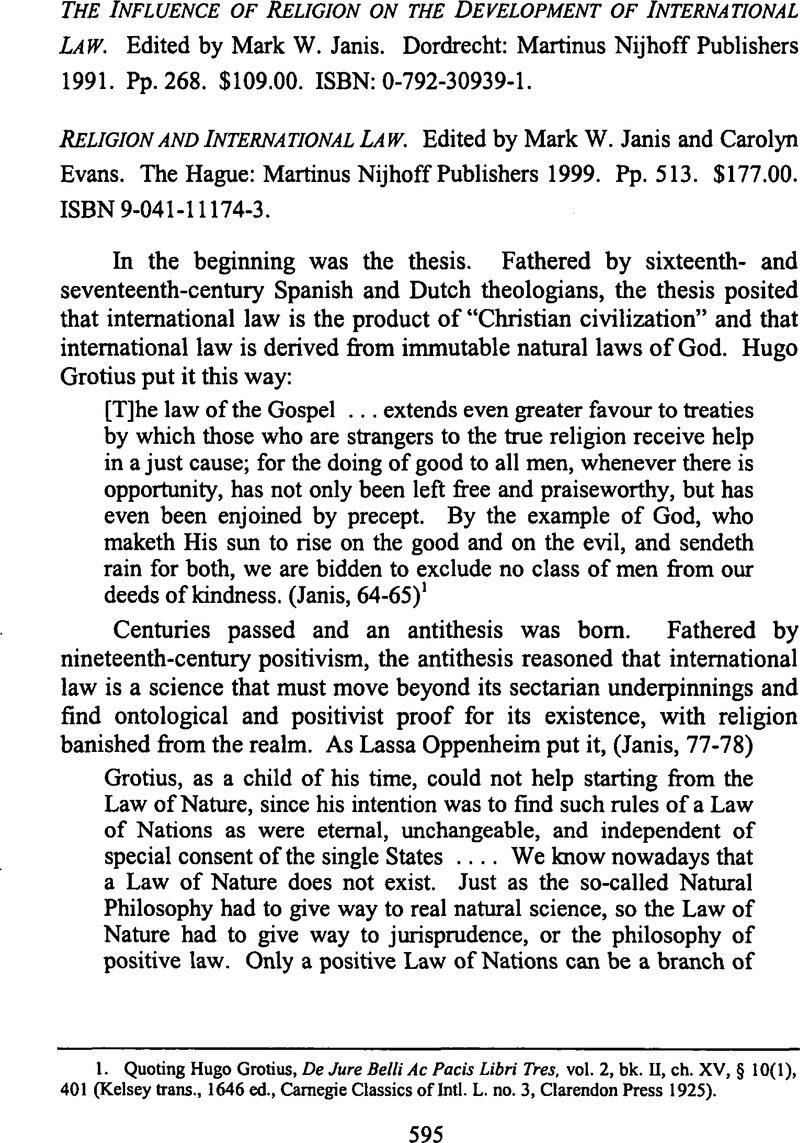No CrossRef data available.
Article contents
The Influence of Religion on the Development of International Law. Edited by Mark W. Janis. Dordrecht: Martinus Nijhoff Publishers1991. Pp.268. $109.00. ISBN: 0-792-30939-1. - Religion and International Law. Edited by Mark W. Janis and Carolyn Evans. The Hague: Martinus Nijhoff Publishers1999. Pp.513. $177.00. ISBN 9-041-11174-3.
Published online by Cambridge University Press: 24 April 2015
Abstract

- Type
- Review Essays and Reviews
- Information
- Copyright
- Copyright © Center for the Study of Law and Religion at Emory University 2001
References
1. Quoting Grotius, Hugo, De Jure Belli Ac Pacis Libri Tres, vol. 2, bk. II, ch. XV, § 10(1), 401 (Kelsey, trans., 1646 ed., Carnegie Classics of Intl. L. no. 3, Clarendon Press 1925)Google Scholar.
2. Quoting Oppenheim, L., International Law: A Treatise vol. 1, 79, 92 (Longmans 1905)Google Scholar.
3. U.N. Charter preamble.
4. Goldsmith, Jack L. & Posner, Eric A., Understanding the Resemblance Between Modern and Traditional Customary International Law, 40 Va. J. Intl. L. 639, 640 (2000)Google Scholar (internal citations omitted), citing The Paquette Habana, 175 U.S. 677 (1900); Filartiga v. Pena-lrala , 630 F.2d 876 (2d Cir. 1980).
5. Bederman, David J., International Law in Antiquity (Cambridge U. Press 2001)CrossRefGoogle Scholar.
6. Oppenheim, supra n. 2, at vol. 1, 33 (Longmans 1905).
7. For the view that Islam is a “civilization” clashing with other civilizations in the world, see Huntington, Samuel, The Clash of Civilizations and the Remaking of the World Order 109-120, 183-186, 209–218 (Simon & Schuster 1996)Google Scholar.
8. Nafzinger defines religion as “a practice of ultimate concern about our nature and obligations as human beings, inspired by experience and typically expressed by members of a group or community sharing myths and doctrines whose authority transcends both individual conscience and the state.” (Janis, 150). Park offers various definitions, including “those most deeply held beliefs that provide ultimate commitment.” (Janis, 183).
9. Vienna Convention on the Law of Treaties, May 23, 1969, art. 53, 1155 U.N.T.S. 332, 344 (defining a jus cogens norm as “a norm accepted and recognized by the international community of States as a whole as a norm from which no derogation is permitted and which can be modified only by a subsequent norm of general international law having the same character”).
10. Grotius, supra n. 2, at vol. 2, Prolegomena, § 3, 9.
11. There are heated debates concerning the merits and demerits of the jus cogens doctrine. See generally Boyd, K. Lee, Are Human Rights Political Questions, 53 Rutgers L. Rev. 277, 312–317 (2001)Google Scholar; Weisburd, A. Mark, The Emptiness of the Concept of Jus Cogens, as Illustrated by the War in Bosnia-Herzegovina, 17 Mich. J. Intl. L. 1, 24–40 (1995)Google Scholar; Nguyen, Kha Q., In Defense of the Child: A Jus Cogens Approach to the Capital Punishment of Juveniles in the United States, 28 G.W. J. Intl. L. & Econ. 401, 416–423 (1995)Google Scholar; Watson, Geoffrey R., The Death of Treaty, 55 Ohio St. L. J. 781, 814–823 (1994)Google Scholar; Lobel, Jules, The Limits of Constitutional Power: Conflicts Between Foreign Policy and International Law, 71 Va. L. Rev. 1071, 1138–1142 (1985)CrossRefGoogle Scholar.
12. See Lowe, Vaughan, The Politics of Law-Making: Are the Method and Character of Norm Creation Changing, in The Role of Law in International Politics: Essays in International Relations and International Law 207, 221–226 (Byers, Michael, ed., Oxford U. Press 2000)Google Scholar.




